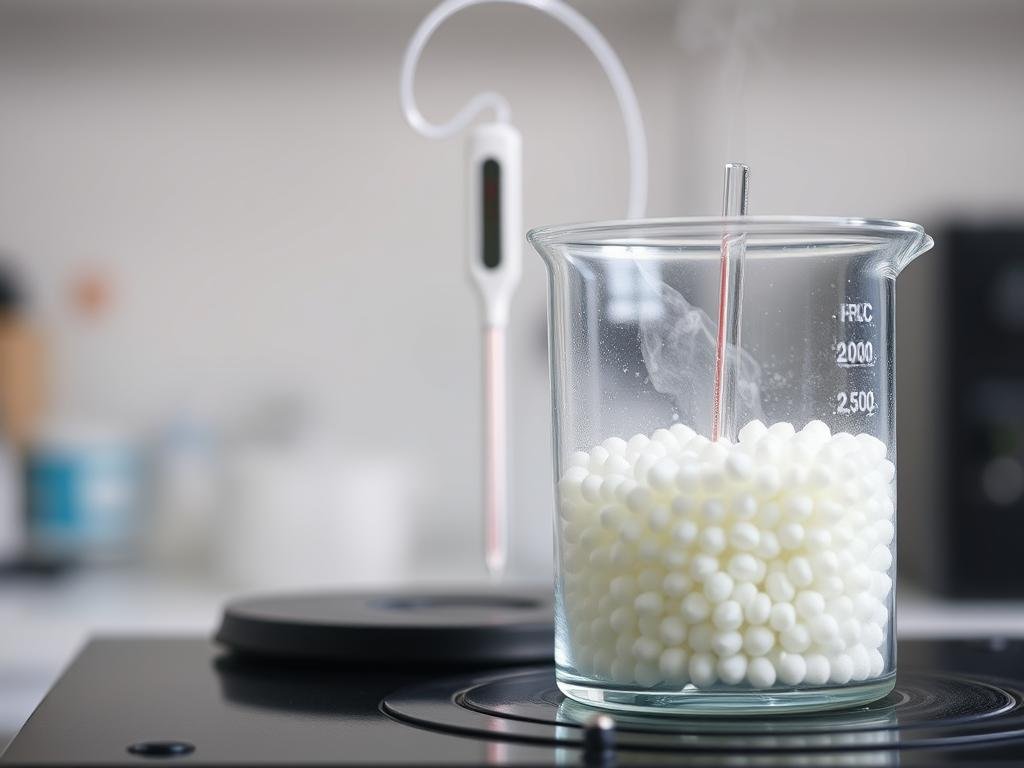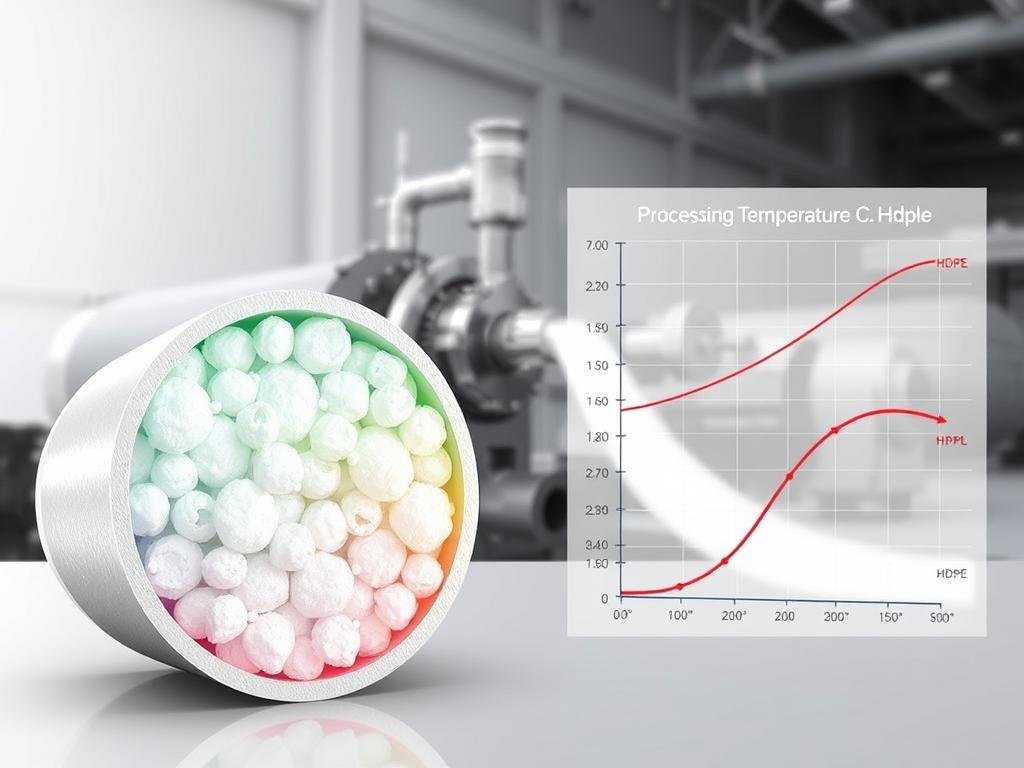High-Density Polyethylene (HDPE) is a versatile plastic material known for its high crystallinity and unique thermal properties. The melting point of HDPE, typically ranging around 135°C (275°F), is a crucial characteristic that influences its applications.
The temperature at which HDPE transitions from a solid to a liquid state is significant for both processing and end-use applications. Understanding this property is essential for manufacturers and engineers working with HDPE.
HDPE’s molecular structure, characterized by a low proportion of side branching groups, contributes to its thermal properties, making it a valuable material across multiple industries.
Understanding High-Density Polyethylene (HDPE)
With its high density and specific molecular arrangement, HDPE exhibits a range of characteristics that make it highly valuable in various applications. Its unique structure grants it superior properties that are not commonly found in other types of polyethylene.
What Makes HDPE Different
HDPE is distinct from other polyethylenes due to its high density and minimal branching, which results in stronger intermolecular forces. This characteristic enhances its strength and resistance to various environmental factors.
Key Physical Properties
HDPE boasts several key physical properties that contribute to its widespread use. Some of its notable attributes include:
- High tensile strength (15.2-45 MPa), ideal for load-bearing applications.
- Outstanding chemical resistance, particularly to acids and bases.
- A Shore D hardness of 55-69, providing good rigidity and impact resistance.
- Low water absorption rate, contributing to its dimensional stability.
| Property | Value | Benefit |
|---|---|---|
| Tensile Strength | 15.2-45 MPa | Load-bearing capacity |
| Chemical Resistance | High | Durable in harsh environments |
| Shore D Hardness | 55-69 | Rigidity and impact resistance |
The combination of these properties makes HDPE a versatile material with excellent performance in a wide range of applications, from piping systems to packaging materials.
The HDPE Melting Point: A Closer Look
To fully leverage HDPE’s potential, it’s necessary to examine its melting point in detail. The melting point is a critical property that determines the suitability of HDPE for various applications.
Typical Melting Range: 120°C to 180°C
The melting point of HDPE typically ranges between 120°C to 180°C. This range is influenced by the material’s molecular structure and crystallinity. The specific melting point within this range can vary based on the HDPE grade and production process.
| Property | Typical Value | Unit |
|---|---|---|
| Melting Point Range | 120 – 180 | °C |
| Crystallinity | 60 – 80 | % |
| Molecular Weight | Varied | g/mol |
How Melting Point is Measured
The melting point of HDPE is typically measured using Differential Scanning Calorimetry (DSC), a thermal analysis technique that tracks heat flow during phase transitions. 
- DSC testing involves heating a small sample of HDPE at a controlled rate alongside a reference material, and recording the difference in heat flow.
- The melting point is identified on the resulting thermogram as an endothermic peak, representing the temperature at which the crystalline regions of the polymer absorb heat to transition from solid to liquid state.
- Standardized test methods, such as ASTM D3418, are used to ensure accurate and consistent measurement of the melting point.
This precise measurement is essential for quality control in manufacturing and for ensuring that HDPE materials meet specific thermal performance requirements.
Factors Affecting HDPE’s Thermal Properties
Understanding the factors that affect HDPE’s thermal properties is essential for optimizing its performance in various applications. Several factors play a crucial role in determining HDPE’s thermal behavior.
Molecular Weight and Structure
The molecular weight and structure of HDPE significantly influence its melting point and thermal stability. Higher molecular weight HDPE tends to have a higher melting point due to its larger molecular size and stronger intermolecular forces.
Crystallinity and Its Impact
Crystallinity is another critical factor affecting HDPE’s thermal properties. Higher crystallinity levels result in a higher melting point because the crystalline regions are more stable and require more energy to melt.
Additives and Their Effects
The presence of additives, such as antioxidants and stabilizers, can slightly alter the melting point of HDPE. These additives can enhance performance or appearance but may affect the temperature at which the plastic melts. Various additives can influence HDPE’s melting behavior and overall thermal properties.
Processing HDPE: Temperature Considerations
When processing HDPE, temperature plays a crucial role in determining the final product’s quality. The thermal properties of HDPE significantly influence its processing and performance in various applications.
Injection Molding Temperature Requirements
Injection molding of HDPE requires precise temperature control. The temperature range for injection molding typically varies, but it’s essential to maintain a consistent temperature to ensure the quality of the final product. Optimal temperature control helps in achieving the desired properties of HDPE.
Extrusion and Other Manufacturing Processes
Extrusion is another common method for processing HDPE, particularly for producing bottles and containers. The process involves heating HDPE to approximately 150°C to 160°C, making it malleable. Various manufacturing processes have different temperature requirements.
| Manufacturing Process | Temperature Range (°C) | Temperature Range (°F) |
|---|---|---|
| Extrusion | 150-220 | 302-428 |
| Thermoforming | 130-150 | 266-302 |
| Rotational Molding | (Oven temperatures) 149-343 | (Oven temperatures) 300-650 |

Applications Leveraging HDPE’s Heat Resistance
HDPE’s heat resistance makes it a versatile material for various applications. Its ability to withstand elevated temperatures without compromising its structural integrity is crucial in several industries.
Construction and Piping Systems
In construction and piping systems, HDPE is valued for its thermal stability and resistance to chemicals. It is used in piping for hot water distribution and industrial effluent handling. The material’s durability and resistance to corrosion make it an ideal choice for these applications.
Packaging Industry Applications
The packaging industry benefits from HDPE’s heat resistance, particularly in the production of containers and bottles that can withstand hot filling processes. HDPE’s chemical resistance also ensures that the packaging material does not react with the contents, maintaining product integrity.
Automotive and Industrial Uses
In the automotive sector, HDPE is used for manufacturing fuel tanks, fluid reservoirs, and other components that are exposed to high temperatures. Industrial equipment also incorporates HDPE parts due to their heat resistance and chemical stability. Examples include HDPE Bumpers, HDPE Dashboard Components, and HDPE Fuel Tanks. The material’s ability to maintain dimensional stability and mechanical properties under varying temperatures makes it suitable for these demanding applications.
- Automotive applications of HDPE include parts that must withstand elevated temperatures, such as fuel tanks and under-hood components.
- Industrial equipment uses HDPE components in areas requiring both heat and chemical resistance.
Conclusion: Why HDPE’s Melting Point Matters
The melting point of HDPE is a critical factor that influences its processing and end-use performance. Knowing this property is essential for determining the appropriate processing temperature, application suitability, and recyclability. Effective material selection relies on understanding HDPE’s thermal behavior. Its relatively high melting point makes HDPE a versatile material for various applications, from construction to packaging. As sustainability concerns grow, HDPE’s recyclability positions it as an environmentally responsible choice. By understanding HDPE’s melting point, engineers and designers can make informed decisions, driving innovation in product design and manufacturing techniques.
